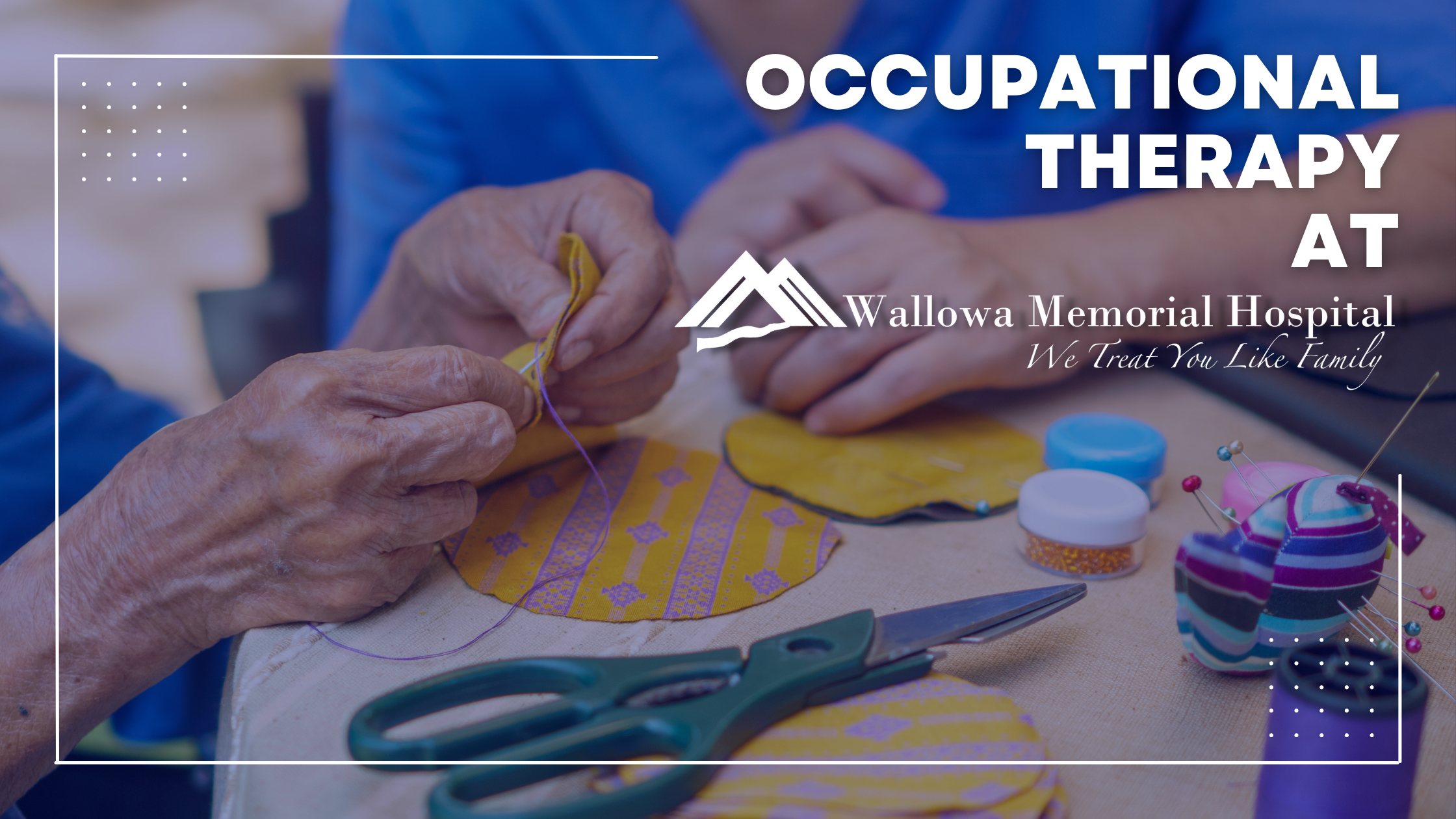
29 Apr Occupational Therapy at WMH
Wallowa Memorial Hospital has an excellent occupational therapy team consisting of three Occupational Therapists who work together to help people of all ages facing physical, sensory, or cognitive problems. Our therapists help people maximize independence in all areas of their lives.
Meet our Occupational Therapists

Angela Mart
Angela has 16 years of experience as an occupational therapist working with adults and has been a valuable member of Wallowa Memorial Hospital’s occupational therapy team since 2016. She provides services in several areas, including neurological disorders like Parkinson’s or MS, strokes, head injuries, activity modification and adaptions, home safety evaluations, memory and attention, and hand and wrist rehabilitation following injuries and surgeries. Angela has provided some helpful tips to prevent some of the most common hand conditions that she treats in the outpatient setting.
Occupational Therapy Tips from Angela
-
- Carpal Tunnel Syndrome is a condition that results in inflammation of the flexor tendons and median nerve in the wrist area, often causing numbness and tingling in the thumb, index finger, and middle finger. Avoid repetitive hand movements, vibration, and non-ergonomic workstations to prevent carpal tunnel syndrome.
- De Quervain’s is a painful ailment that affects the tendons on the thumb side of the wrist resulting in inflammation and pain. It is an overuse injury often caused by prolonged gripping, pinching, and squeezing. Taking breaks from these positions can reduce your risk of developing this condition. New mothers should switch sides when holding their babies instead of holding them consistently on the right or left.
- Lateral epicondylitis (tennis elbow) is an inflammation around the bony knob on the outer side of the elbow. It affects the forearm’s extensor muscles, often causing pain with rotation of the forearm and heavy lifting. Swelling may occur at the outer elbow too. Shoveling snow is often a cause of tennis elbow. Conditioning muscles for specific activities, doing warm-up/cool-down exercises, and using the correct equipment can reduce your chances of developing this condition.
Natalie Butz
Natalie has nine years of experience as an Occupational Therapist working in various settings and across populations from birth through the lifespan. She is passionate about mind/body and promotes balance, strength, self-awareness, executive functioning, and development within the pediatric population. She offers ideas on supporting executive function for both kids and adults.
Occupational Therapy Tips from Natalie
Movement is medicine when it comes to helping you self-regulate. Introducing small mindful movements throughout the day and a morning routine can help your body get your brain ready for daily tasks. Try this mindful movement task.
The Bottom-Up Approach
Movement is medicine when it comes to helping you self-regulate. Introducing small mindful movements throughout the day and a morning routine can help your body get your brain ready for the tasks of the day. Try this mindful movement task.
- Put one hand on your chest and one hand on your belly, then take a deep breath through the nose, raising the chest and after raising the belly. As you breathe out, the belly falls, followed by the chest. Repeat this five times.
- Wiggle. Starting from your head, wiggle your ears, eyebrows, nostrils, lips, cheeks, chin, neck, shoulders, elbows, wrists, fingers, chest, belly, hips, booty, knees, ankles, and toes. Wiggle your way to work, and ask yourself, which body part felt the best to wiggle? If you need a short break, try a wiggle between reading sentences in that email or writing back
The Top-Down Approach
Brains are powerful beings. They turn mental signals on and off. Have you ever cut yourself and not even noticed because you were so engrossed in something else? Well, let’s use that muscle for good. Try this brain workout:
- Awareness walk: Take a short walk. Where and how long doesn’t matter. While walking, become aware of your surrounding through your senses. Can you see and describe five things (item, color, shape), can you feel and describe four things (texture), can you hear three sounds, can you smell two scents.
- Let’s get that brain to turn off the world and into your project. Look at your hands, and choose your favorite one. With the other hand, press into each finger crease, move up and over, starting from the pinky. As you press, tell yourself the task that needs to start and the first step you need to take. Now repeat that first step as you press through your fingers. Repeat it to yourself three times. Once you get to the thumb, you know what you need to do, 3-2-1. Take your favorite hand and move to that task. When you need another break, repeat and find your next project.
Organizational Tips to Help in a Hurry
- Technology: Calendars can help keep you on task. Try using your phone to track appointments and to-do lists. Make a different calendar name and color for work, responsibilities, meetings, and vacations. Set two alarms for priority things, one for the day before the task is due and one for the day of the task.
- Stations: Create a station in each room that has the typical small items you need for the room. Does your living room have a station where you keep remotes and magazines, does your front door have a station for keys, headlamps, jackets, and leashes, and does your bedroom have a station for wallets and cell phones? Stations can help you always locate those frequently lost items.
- Vision: Use your sight to help you attend to your to-do list. Need to remember to grab your lunch? Put a post-it note on the front door or a fork on the counter to remind you the food is in the fridge. Place something out of place to trigger your memory! Your eyes will be your memory guide.
- Memory: Trying to remember something, but you only have your brain handy? Think Peat, repeat. Whatever you’re trying to say, say it to yourself twice, then visualize the information as a story or an action. After visualizing, say it aloud to yourself – can you hear the information? Say it quietly to yourself, how does your mouth move when you form the words?
Adaline Boden
Adaline has four years of experience working in pediatric occupational therapy. Most of her experience has been working with individuals dealing with sensory processing deficits and maladaptive behaviors. These deficits and behaviors are usually a result of sensory modulation difficulties. She shares some ideas on managing sensory overload in our everyday lives.
Occupational Therapy Tips from Adaline
Bright/flashing lights, loud or sudden noises, crowds, clutter, and perfumes are all things that can cause a sensory overload, an internal response that occurs when the senses are overstimulated. Sensory overload usually results in a lack of focus, anxiety, mood swings, discomfort in the eyes or ears, fidgeting, exhaustion, and stress during social situations.
Here are some strategies to minimize sensory overload in adults:
- Identify the trigger. Think of environments that may cause stress or make you feel uncomfortable (messy desk, too much background noise, smells). Once triggers are identified, you can start to create a safe space. Safe spaces provide a place of peace and comfort and support positive coping skills. Typically, safe spaces consist of things that offer relief, such as favorite scents, calm lighting, music, or anything you gravitate toward when trying to relax.
- Create a sensory-friendly kit: Several tools that support self-regulation are noise-canceling headphones, diffusers, crunchy snacks, cold drinks, relaxing music, visually calming pictures, fidgets, and weighted items. When using a weighted blanket, occupational therapists recommend a blanket that is 10% of their body weight + 1 to 2 pounds for therapeutic effect. Have these items available for use when needing a quick break or when starting to feel overwhelmed.
- Develop a routine: Having a predictable routine can be an effective way to manage sensory overload. Routines ensure you are engaging in meaningful activities between high-demand tasks. Which, in return, makes you less likely to get into sensory situations that induce stress. Go for a walk, get up and grab a cold drink, have a snack, meditate, etc.
For questions on how occupational therapy can help you call Wallowa Memorial Hospital Rehabilitation Services at 541-426-5314.





Joy Royse Gerner
Posted at 19:47h, 04 AugustNatalie, this is Joy Royse Gerner and you came to my house three weeks ago. you mentioned you were going to send some links to help with my parkinsons. Can you please review and send them? Your visit was very helpful.